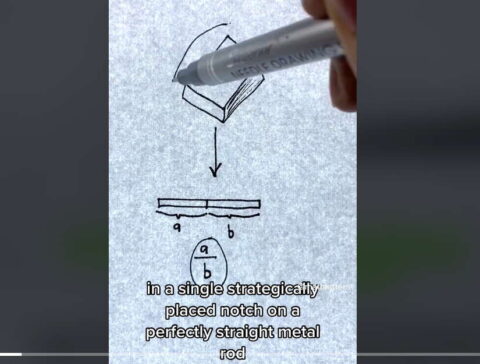TL:DR – A thought experiment that could encode the whole of literature in a single notch in a metal rod.
An intriguing thought experiment explains how one might encode the whole of literature in a single fraction, a/b, and how that ratio might be made physical as a notch in a metal rod, whereby the length on the left of the notch is a and that on the right is b.

How might that be done? Well, if we assume we’re using just the English alphabet, we could assign each letter a code, 001 for the letter a, 002 for the letter b, 003 for c, and so on. 000 could represent a space. Numbers beyond 026 would be the punctuation marks.
So, all of literature could be written out as a continuous sequence of those three-digit codes. There’d be a lot, obviously, there are billions and billions of letters across the whole history of the written word. But, it would be possible.
Now comes the clever bit. That number is a finite whole number, it doesn’t go on forever. So, if we put a zero followed by a decimal point at the beginning, we would have a decimal fraction. Any decimal fraction of limited length can be represented as a ratio of two whole numbers. They are rational unlike numbers such as pi or e, which are irrational and can never be calculated fully as they go on forever. Thus, we have that fraction, that ratio. All we need to do now is take out metal rod and put a notch in it at the point where that fraction is represented by the distance from one end to the notch over the distance from the other end to the notch.
It’s clever isn’t it? I imagine this idea has been invented several times before, but I think the first time I came across it was in a recent TikTok video here.
Anyway, that’s a theoretical system for encoding the whole of human literature with a single mark on a metal rod. But, would it work in practice? I suspect not. The encoded fraction that gives us the decimal fraction that represents all of literature will be absolutely enormous, many millions of digits in the numerator and the denominator, perhaps more, I cannot quite imagine how long the string of numbers would be…
As such marking a notch with such precision on a metal rod is going to require an incredibly accurate means of measuring marking the rod. I am guessing that with a rod just a metre long, the precision needed will come up against the quantum limit and at that limit it would be impossible to make such a mark because we couldn’t move the marker accurately and know precisely where it is on the rode. We might try a longer rod, but I suspect it would need to be incredibly long, perhaps even millions of kilometres, perhaps lightyears long to allow a notch to be made and at astronomical scales relativistic effects will come into play.
Then, there are the issues of fabricating a uniform and chemically pure rod that is stable, resists oxidation and degradation, that would theoretically be impossible too. On top of that we must take into account expansion and contraction that would take place with a rise and fall in temperature and the resulting distortions to the rod and the notch that might occur with such fluctuations.
It’s not looking good for encoding the whole of literature in this way. Perhaps we could start with a short children’s book as a preliminary test and see how well we could do that. Seeing as we seem to have gone done a weird rabbit hole, perhaps we could start with Alice’s Adventures in Wonderland.
There is a twist in the tale though. You remember I mentioned how the irrational number pi cannot be represented by a fraction because it goes on forever, well a big chunk of pi could be sliced out of the irrational number and used to generate a ratio. If we searched pi for long enough we would actually find a slice that represented the a/b we were looking to represent all of literature in a single ratio.
Moreoever, because pi goes on forever, the whole of literature is encoded somewhere in pi already and it is repeated an infinite number of times. And, double moreover, the whole of the future of literature, all those books yet to be written are encoded somewhere in pi, but you have to find the right chunk to work on! In fact, somewhere in the eternity of pi all information that has existed and might one day exist is encoded in pi. At some point within the random digits of pi, we might even take out slice to explain life, the universe, and everything…imagine the meaning of life in pi, and it is not just 42.